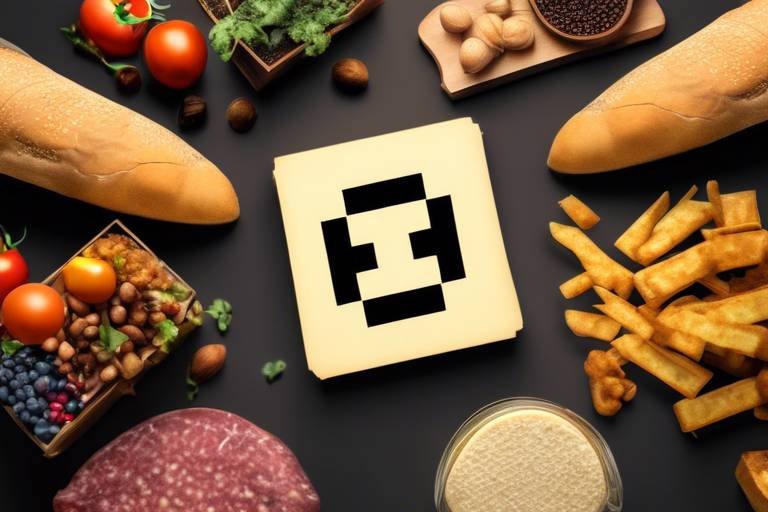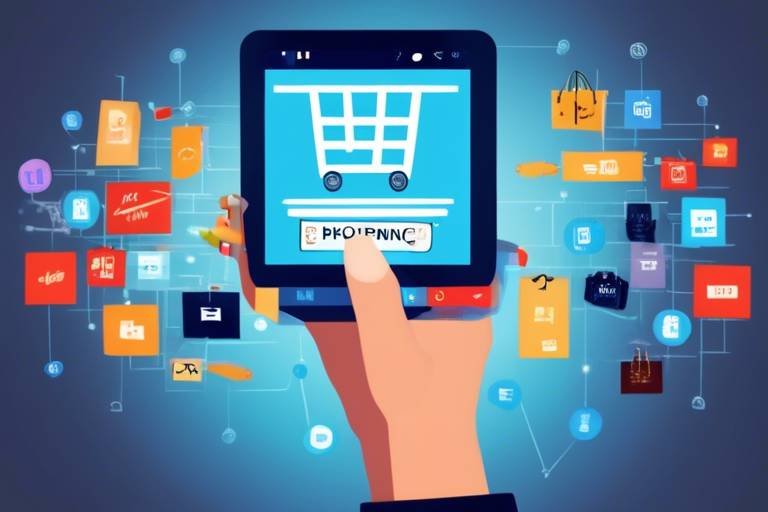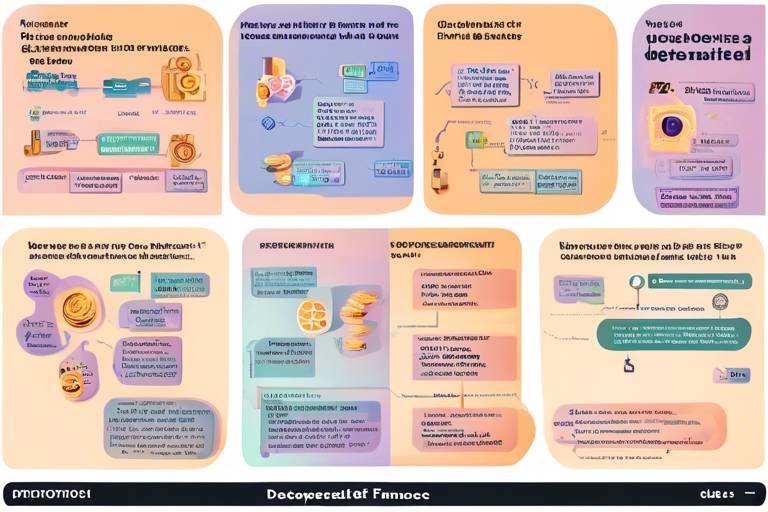How Blockchain is Transforming the Food Industry
In today’s fast-paced world, where consumers are increasingly concerned about what they eat, blockchain technology is emerging as a game changer in the food industry. Imagine being able to trace your avocado back to the very farm it was grown on, knowing every step it took before reaching your plate. This is not just a dream; it's becoming a reality thanks to blockchain. By providing a secure and transparent digital ledger, blockchain is revolutionizing how food is sourced, tracked, and delivered. It enhances transparency and traceability in supply chains, ensuring that consumers can make informed choices about the food they consume. But how exactly is this technology transforming the food landscape? Let’s dive deeper into the various ways blockchain is reshaping the food industry.
At its core, blockchain technology is a decentralized and secure digital ledger that records transactions across many computers. This means that once information is entered, it cannot be altered without the consensus of the network. Understanding the fundamentals of blockchain is crucial, especially as it finds applications in various sectors, including the food industry. The transparency it provides is akin to having a window into the entire supply chain, allowing stakeholders—from farmers to consumers—to see exactly where their food comes from and how it was handled. This level of visibility is not just beneficial; it’s essential in today’s world where food safety and quality are paramount.
One of the most significant advantages of blockchain in the food industry is its ability to enhance traceability. Imagine being able to track a product from the moment it leaves the farm to the moment it lands on your dinner table. With blockchain, this is possible. Each transaction is recorded in real-time, creating a comprehensive history of the product. This traceability not only ensures that consumers can verify the origins of their food but also promotes safety and quality assurance. For instance, if a contamination issue arises, blockchain allows for quick identification of the source, enabling swift action to mitigate risks.
Food safety is a critical concern for consumers and producers alike. By providing complete visibility into the supply chain, blockchain plays a vital role in identifying contamination sources quickly. This capability significantly reduces the impact of foodborne illnesses, enhancing overall food safety standards. When every step of the supply chain is recorded and accessible, it becomes much easier to pinpoint where things went wrong. This not only protects consumers but also helps companies maintain their reputations and adhere to regulatory standards.
Several companies have already adopted blockchain technology to improve food safety. For example, Walmart has implemented blockchain to track the origin of its leafy greens, significantly reducing the time it takes to trace contaminated products from days to mere seconds. Similarly, IBM’s Food Trust platform has enabled various stakeholders, including suppliers and retailers, to collaborate more effectively, ensuring that food safety is prioritized. These case studies reveal valuable insights into effective strategies and the positive outcomes achieved through this innovative approach.
Despite its numerous advantages, implementing blockchain in food supply chains is not without challenges. Some of the key hurdles include:
- High Costs: The initial investment for blockchain technology can be substantial.
- Technological Barriers: Not all stakeholders may have the necessary technical expertise to adopt blockchain.
- Industry-Wide Collaboration: Successful implementation requires cooperation among various players in the supply chain.
Overcoming these challenges is crucial for realizing the full potential of blockchain in the food industry.
With increased transparency comes boosted consumer confidence. Shoppers today are more informed than ever and are actively seeking out brands that prioritize transparency. Blockchain allows consumers to access detailed information about the food they purchase, including its journey from farm to table. This access empowers consumers to make informed decisions, fostering a greater willingness to support brands that are committed to transparency and quality.
Beyond transparency, blockchain also simplifies supply chain operations. By automating processes and reducing paperwork, it leads to significant cost savings and faster transactions. This efficiency benefits both producers and consumers, making the entire supply chain more agile and responsive to market demands.
Food fraud is a growing concern, with counterfeit products making their way into the market. Blockchain’s immutable records help combat this issue by ensuring that product claims are verified and traceable. This not only protects brands but also safeguards consumers from purchasing counterfeit products. When consumers can trust that what they’re buying is genuine, it enhances the overall integrity of the food industry.
As technology continues to evolve, the integration of blockchain in the food industry is expected to grow. Future trends may include enhanced data analytics capabilities, more widespread adoption of IoT devices for real-time tracking, and even greater collaboration across the supply chain. Exploring these trends can provide valuable insights into potential advancements and innovations on the horizon, as the food industry embraces the digital age.
- What is blockchain technology? Blockchain is a decentralized digital ledger that records transactions securely and transparently.
- How does blockchain improve food safety? It enhances traceability, allowing for quick identification of contamination sources.
- What are the main challenges of implementing blockchain in food supply chains? High costs, technological barriers, and the need for industry-wide collaboration are significant challenges.
- What companies are using blockchain in the food industry? Companies like Walmart and IBM are leading the way in implementing blockchain for food safety.
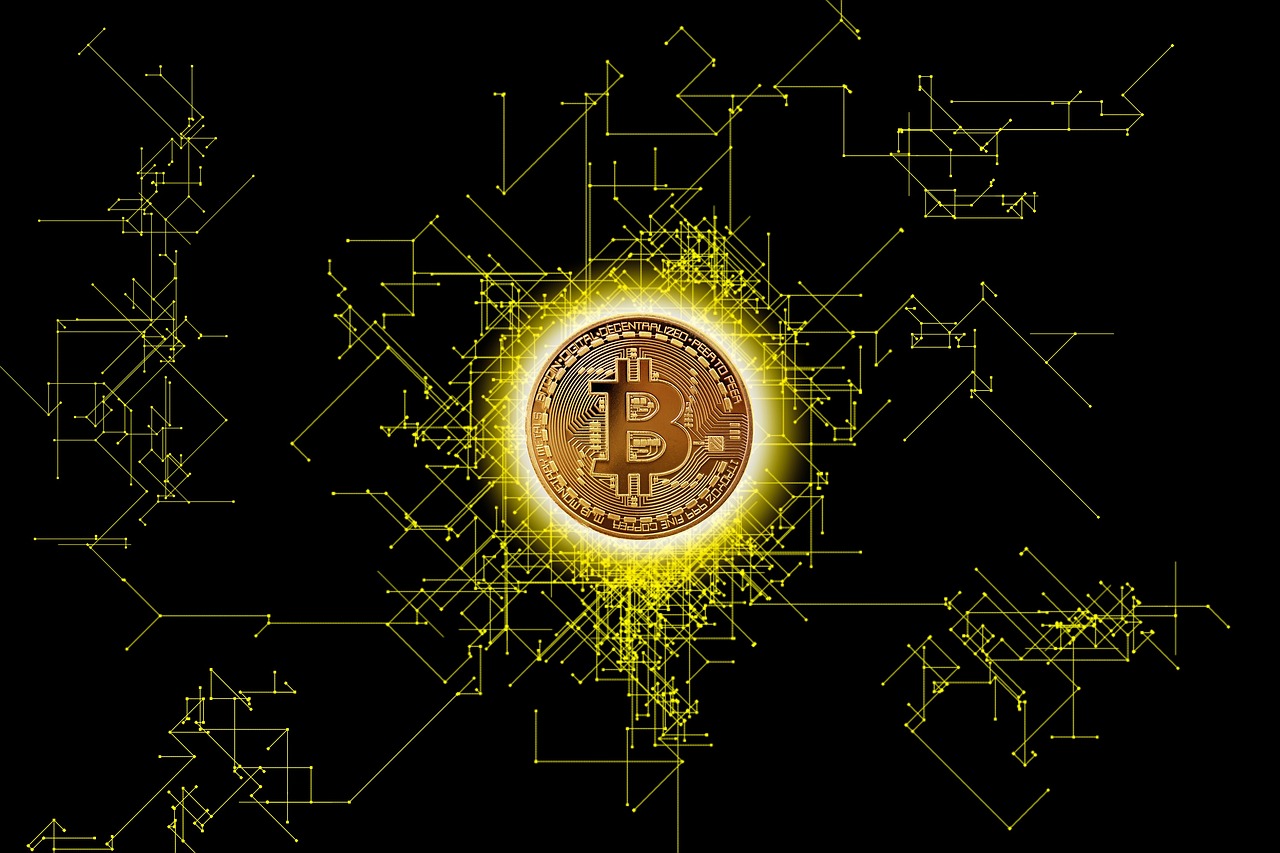
Introduction to Blockchain Technology
Blockchain technology is often hailed as a groundbreaking innovation that is reshaping various industries, and the food sector is no exception. At its core, blockchain is a decentralized digital ledger that records transactions across numerous computers in such a way that the registered information cannot be altered retroactively. This inherent security and transparency make blockchain an ideal solution for enhancing the food supply chain.
Imagine a world where every food product you purchase comes with a detailed history of its journey from the farm to your plate. With blockchain, this is not just a dream but a tangible reality. Each transaction related to a food item—from harvesting and processing to distribution and retail—can be securely recorded on the blockchain. This means that consumers can have access to vital information, such as where their food was grown, how it was processed, and whether it met safety standards.
Understanding the fundamentals of blockchain is essential for grasping its applications in the food industry. Here are some key elements:
- Decentralization: Unlike traditional databases controlled by a single entity, blockchain operates on a network of computers, making it less vulnerable to fraud and manipulation.
- Transparency: Every participant in the network can view the entire history of transactions, fostering trust among consumers and producers alike.
- Immutability: Once data is entered into the blockchain, it cannot be changed or deleted, ensuring the integrity of the information.
These features not only enhance traceability but also pave the way for more efficient operations within the food industry. As we delve deeper into how blockchain is transforming food supply chains, it becomes clear that this technology is not just a passing trend but a revolutionary force that promises to reshape how we think about food safety, quality, and trust.

Enhancing Traceability in Food Supply Chains
In today's fast-paced world, where consumers are increasingly concerned about what they eat, traceability in food supply chains has become more important than ever. Blockchain technology offers a revolutionary solution to this challenge, enabling real-time tracking of food products from the moment they are harvested to when they reach your plate. Imagine being able to scan a QR code on your food packaging and instantly accessing a detailed history of that product, including its origin, journey, and even the conditions under which it was stored. This level of transparency not only promotes safety but also assures consumers about the quality of their food.
With blockchain, every transaction and movement of food is recorded in a digital ledger that is accessible to all stakeholders in the supply chain. This means that farmers, distributors, retailers, and consumers can all verify the authenticity of the product. For instance, if a consumer discovers that a particular batch of lettuce is contaminated, blockchain allows for swift identification of the source of contamination, enabling rapid response measures to prevent further spread of foodborne illnesses. This capability is a game-changer in enhancing food safety standards.
Moreover, the ability to trace food back to its origins empowers consumers with information that can influence their purchasing decisions. They can choose to buy from brands that prioritize ethical sourcing and sustainability. This not only boosts consumer confidence but also encourages companies to adopt better practices, knowing that their efforts will be recognized and rewarded in the marketplace.
To illustrate the impact of blockchain on traceability, consider the following table showcasing key benefits:
| Benefit | Description |
|---|---|
| Real-time Tracking | Allows for immediate access to product journey and history. |
| Quick Identification of Contamination | Facilitates rapid response to food safety issues. |
| Consumer Empowerment | Informs consumers about the origins and handling of their food. |
| Increased Brand Trust | Encourages businesses to maintain high-quality standards. |
However, while the benefits are clear, the implementation of blockchain technology in food supply chains is not without its challenges. High initial costs, the need for technological infrastructure, and the necessity for widespread collaboration among industry players can pose significant hurdles. Nevertheless, the potential rewards of enhanced traceability make it a worthwhile investment for the future of food safety and consumer trust.
In conclusion, enhancing traceability in food supply chains through blockchain technology is not just a trend; it is a transformative step towards a safer, more transparent food system. As consumers become more aware and demanding, the pressure on companies to adopt these technologies will only increase, paving the way for a new era of food safety and quality assurance.
- What is blockchain technology? Blockchain is a decentralized digital ledger that records transactions across many computers securely and transparently.
- How does blockchain enhance food traceability? It allows for real-time tracking of food products, providing a detailed history from farm to table.
- What are the challenges of implementing blockchain in the food industry? Challenges include high costs, technological barriers, and the need for collaboration among various stakeholders.
- How can consumers benefit from blockchain in food supply chains? Consumers gain access to information about the origins and handling of their food, leading to informed purchasing decisions.
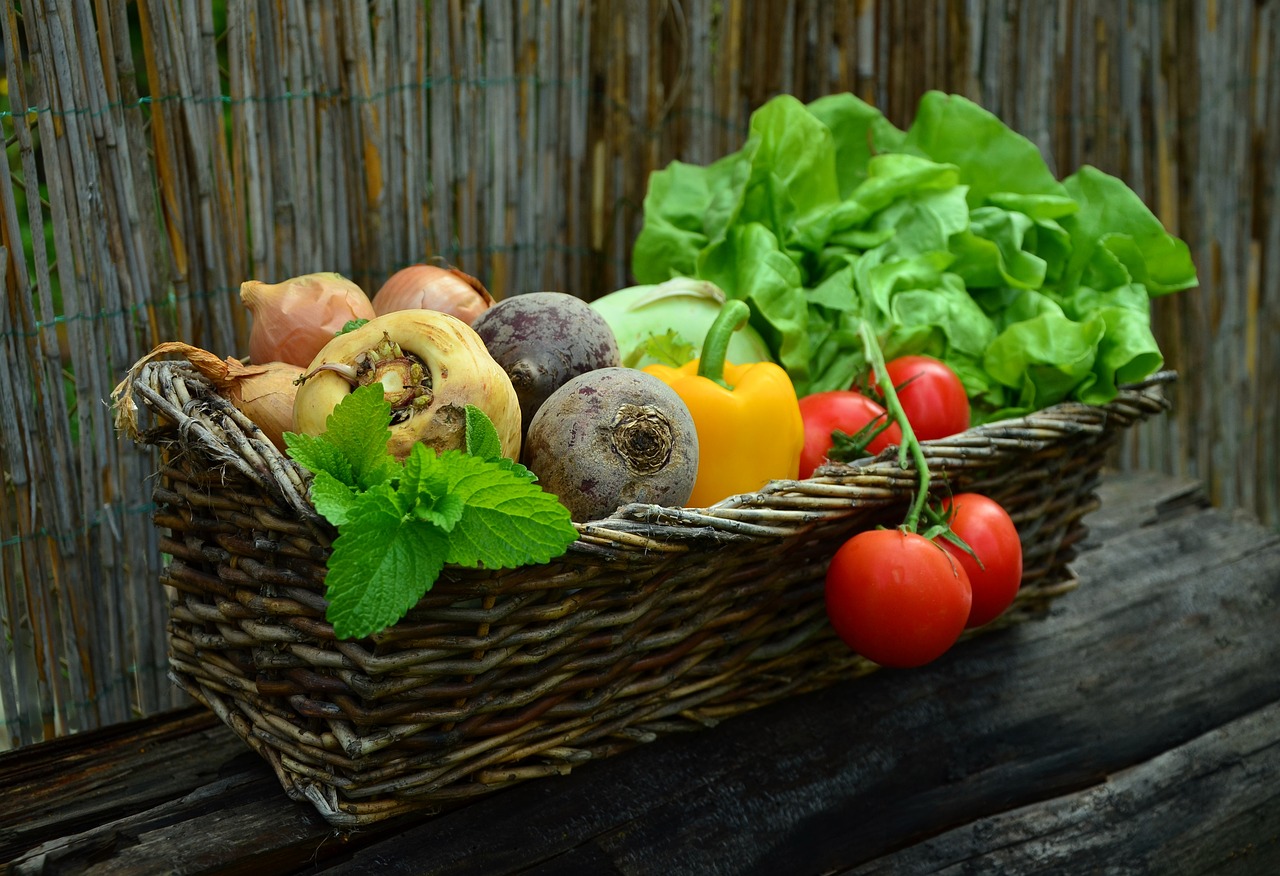
Improving Food Safety
When it comes to food safety, blockchain technology is a game changer. Imagine being able to track every step your food takes from the farm to your plate. With blockchain, this isn't just a dream—it's a reality. The decentralized and transparent nature of blockchain allows for real-time tracking of food products, which means that if something goes wrong, we can pinpoint the source of contamination almost instantly. This capability is crucial in a world where foodborne illnesses can spread like wildfire and have devastating effects on public health.
Consider a scenario where spinach is found to be contaminated with E. coli. In a traditional system, tracing the source of the contamination could take days or even weeks, leading to more people getting sick. However, with blockchain, every transaction, every movement of that spinach from the farm to the grocery store is recorded in an immutable ledger. This allows food safety officials to quickly identify the farm where the spinach was harvested, the distribution centers it passed through, and the stores where it was sold. The result? Faster recalls and less risk to consumers.
Moreover, the transparency provided by blockchain technology fosters accountability among all players in the supply chain. Farmers, distributors, and retailers are incentivized to adhere to safety standards because any negligence can be traced back to them. This not only enhances food safety but also encourages a culture of compliance and responsibility. To illustrate this point, let’s take a look at a few key benefits of blockchain in food safety:
- Rapid Response to Contamination: Quick identification of contaminated products minimizes health risks.
- Enhanced Compliance: Stakeholders are more likely to follow safety standards when they know their actions are being recorded.
- Consumer Trust: Transparency builds consumer confidence, knowing they can trace the origins of their food.
While the benefits are clear, it's also important to recognize the challenges that come with implementing blockchain in food safety systems. These challenges include the initial investment costs, the need for training, and the integration of existing systems with new technology. However, as the food industry continues to evolve, the long-term benefits of blockchain far outweigh these hurdles.
In conclusion, the integration of blockchain technology in food safety not only enhances traceability and accountability but also significantly reduces the risks associated with foodborne illnesses. As consumers become more health-conscious and demand transparency about their food sources, blockchain stands out as a vital tool in ensuring that the food we eat is safe and trustworthy.
Q: How does blockchain improve food safety?
A: Blockchain improves food safety by providing real-time tracking of food products, allowing for quick identification of contamination sources and ensuring accountability among stakeholders.
Q: What are the challenges of implementing blockchain in the food industry?
A: Some challenges include high initial costs, technological barriers, and the need for industry-wide collaboration and training.
Q: Can consumers access information about the origins of their food through blockchain?
A: Yes, blockchain technology allows consumers to trace the origins of their food products, enhancing transparency and trust.

Case Studies of Successful Implementations
In recent years, several companies have successfully integrated blockchain technology into their operations, showcasing its potential to revolutionize the food industry. One of the most notable examples is Walmart, which partnered with IBM to create a blockchain-based food traceability system. This initiative allows Walmart to track the journey of produce from farm to store in real-time. By scanning a QR code, customers can access detailed information about the origins of their food, including where it was grown and how it was transported. This level of transparency not only enhances consumer trust but also allows Walmart to quickly identify and address any food safety issues, significantly reducing the risk of contamination outbreaks.
Another compelling case study comes from Nestlé, which has implemented blockchain to ensure the authenticity of its products. The company launched a project called “The Blockchain for Food”, where consumers can trace the entire supply chain of their food products. For instance, when purchasing a jar of baby food, a consumer can see the exact farms where the ingredients were sourced, how they were processed, and the logistics involved in bringing the product to market. This initiative not only boosts consumer confidence but also reinforces Nestlé's commitment to sustainability and ethical sourcing.
Moreover, Unilever has embraced blockchain to combat food fraud, particularly in its tea supply chain. By using blockchain technology, Unilever can verify that its tea products are sourced from certified farms that adhere to sustainable practices. This system creates a transparent and trustworthy supply chain, allowing consumers to know they are purchasing genuine products. Unilever's efforts demonstrate how blockchain can be a powerful tool in promoting ethical practices within the food industry.
To summarize, these case studies illustrate the diverse applications of blockchain technology in enhancing food safety, traceability, and consumer trust. The successful implementations by companies like Walmart, Nestlé, and Unilever highlight the transformative potential of blockchain in addressing some of the most pressing challenges in the food industry today.
- What is blockchain technology?
Blockchain is a decentralized digital ledger that records transactions across many computers in a way that the registered transactions cannot be altered retroactively. - How does blockchain improve food safety?
By providing real-time tracking and complete visibility of the food supply chain, blockchain helps quickly identify contamination sources and enhances overall food safety standards. - Can consumers access information about their food through blockchain?
Yes, blockchain enables consumers to trace the origin of their food products, ensuring they can make informed choices about what they purchase. - What are some challenges of implementing blockchain in the food industry?
Challenges include high costs, technological barriers, and the need for collaboration across the entire industry.

Challenges in Implementation
Implementing blockchain technology in the food industry is not without its hurdles. While the benefits are substantial, the path to adoption can be steep and fraught with challenges. One of the primary concerns is the high costs associated with integrating blockchain systems into existing supply chain infrastructures. Many companies, especially small and medium-sized enterprises, may find the initial investment daunting. This includes not only the technology itself but also the necessary training for staff to effectively use these systems.
Moreover, there are significant technological barriers that need to be addressed. Blockchain is a relatively new technology, and many stakeholders in the food industry may lack the technical expertise required to implement and maintain such systems. This knowledge gap can lead to resistance from employees and management alike, creating a bottleneck in the adoption process.
Another critical challenge is the need for industry-wide collaboration. For blockchain to be truly effective in enhancing traceability and transparency, all players in the supply chain, from farmers to retailers, must be willing to participate. This requires a shift in mindset and a commitment to sharing information, which can be difficult in an industry where competition is fierce. Without a unified approach, the potential of blockchain remains largely untapped.
Additionally, regulatory and compliance issues can complicate the implementation process. Different regions may have varying regulations regarding data privacy and food safety, making it essential for companies to navigate these legal landscapes carefully. This complexity can slow down the adoption of blockchain solutions, as companies may hesitate to invest in technology that could lead to compliance issues.
In summary, while the implementation of blockchain in the food industry offers a wealth of opportunities, it is essential to acknowledge the challenges that lie ahead. Addressing these issues will require a collaborative effort among industry stakeholders, investments in technology and training, and a commitment to navigating the regulatory landscape effectively.
- What is blockchain technology?
Blockchain technology is a decentralized and secure digital ledger that records transactions across multiple computers, ensuring transparency and preventing tampering.
- How does blockchain enhance food safety?
By providing real-time tracking and traceability of food products, blockchain helps identify contamination sources quickly, thus improving food safety standards.
- What are the main challenges in implementing blockchain in the food industry?
The main challenges include high costs, technological barriers, the need for industry-wide collaboration, and regulatory compliance issues.
- Can small businesses afford to implement blockchain technology?
While the initial investment can be high, the long-term benefits such as improved efficiency and reduced fraud can make it worthwhile for small businesses to consider.

Boosting Consumer Confidence
In today's fast-paced world, where consumers are more informed than ever, transparency has become a cornerstone of trust in the food industry. Imagine walking into a grocery store and being able to scan a QR code on a product to unveil its entire journey—from the farm to your plate. That’s the power of blockchain technology! By providing detailed information about the origins, handling, and processing of food items, blockchain fosters an environment where consumers can make informed choices.
When consumers know exactly where their food comes from, it creates a sense of security. They can verify whether the products they buy are organic, sustainably sourced, or free from harmful additives. This level of transparency not only enhances consumer confidence but also encourages them to support brands that prioritize ethical practices. In fact, studies have shown that consumers are willing to pay a premium for food products that offer clear traceability. It’s like having a backstage pass to the food production process!
Moreover, the information provided through blockchain isn’t just about the product itself; it also includes details about the suppliers and their practices. This means that consumers can choose to support local farmers or businesses that align with their values. For instance, if a consumer is passionate about sustainability, they can easily find products that are sourced from environmentally responsible farms. This not only empowers consumers but also drives businesses to adopt better practices to meet the growing demand for transparency.
But let’s not forget about the role of technology in facilitating this transparency. With the rise of mobile apps and digital platforms, accessing blockchain data has never been easier. Consumers can simply use their smartphones to gather information about their food, making it a seamless part of their shopping experience. As more people become aware of these capabilities, we can expect a shift in consumer behavior towards brands that leverage blockchain for transparency.
In summary, blockchain technology is revolutionizing consumer confidence in the food industry by:
- Providing detailed product information: Consumers can trace the journey of their food.
- Encouraging ethical consumption: Shoppers can choose brands that align with their values.
- Enhancing safety: Transparency helps in quickly identifying and addressing food safety issues.
As we look to the future, it’s clear that the integration of blockchain technology will continue to reshape the relationship between consumers and food producers. With each passing day, the demand for transparency is only going to grow, and brands that adapt to this change will not only gain consumer trust but also thrive in an increasingly competitive market.
Q1: How does blockchain ensure food safety?
A1: Blockchain provides complete visibility into the supply chain, allowing for quick identification of contamination sources, thus enhancing food safety standards.
Q2: Can consumers access information about all food products?
A2: Yes! With the use of mobile apps and QR codes, consumers can access detailed information about the origins and handling of many food products.
Q3: Are there any downsides to using blockchain in the food industry?
A3: While blockchain offers many benefits, challenges such as high implementation costs and the need for industry-wide collaboration can hinder its adoption.

Streamlining Supply Chain Processes
In the fast-paced world of food production and distribution, efficiency is key. Blockchain technology is stepping in like a superhero, ready to save the day by streamlining supply chain processes. Imagine a world where every step of food production—from the farm to your fork—is documented in a secure, transparent way. This isn’t just a dream; it’s becoming a reality thanks to blockchain. By automating various processes and reducing the need for endless paperwork, blockchain is revolutionizing how food is tracked, stored, and delivered.
Think about it: every time you buy a product, there’s a complex web of transactions, logistics, and communications that take place behind the scenes. Traditional supply chains can be cumbersome, often involving multiple intermediaries that make tracking and verification a nightmare. With blockchain, however, each transaction is recorded in a decentralized ledger, accessible to all authorized parties. This not only speeds up operations but also significantly reduces the chances of errors and fraud.
One of the most exciting aspects of this technology is its ability to automate processes. For instance, smart contracts—self-executing contracts with the terms of the agreement directly written into code—can trigger automatic payments when goods are delivered. This means no more waiting for invoices to be processed or payments to be approved. Everything happens in real-time, which is a game-changer for producers and consumers alike.
Moreover, the reduction of paperwork cannot be overstated. The food industry is notorious for its extensive documentation requirements, which can slow down operations and lead to costly delays. With blockchain, much of this documentation can be digitized and stored securely, allowing for quick access and verification. This not only saves time but also reduces the risk of lost or damaged paperwork, ensuring that every transaction is accounted for.
To illustrate the impact of blockchain on supply chain efficiency, let's look at a simple comparison:
| Traditional Supply Chain | Blockchain-Enabled Supply Chain |
|---|---|
| Multiple intermediaries involved | Direct transactions between parties |
| Time-consuming paperwork | Digitized records and smart contracts |
| Higher risk of fraud | Immutable and verifiable records |
| Delayed payments | Instant transactions |
As you can see, the differences are striking. The shift towards a blockchain-enabled supply chain not only enhances efficiency but also contributes to a more sustainable and responsible food industry. By reducing waste and improving logistics, blockchain helps ensure that food reaches consumers faster and fresher than ever before.
In conclusion, the integration of blockchain technology into food supply chains is not just a trend; it’s a fundamental shift that promises to enhance efficiency, reduce costs, and improve overall food safety. As more companies recognize the benefits, we can expect to see a broader adoption of blockchain solutions, paving the way for a more transparent and streamlined food industry.
- What is blockchain technology? Blockchain is a decentralized digital ledger that securely records transactions across multiple computers.
- How does blockchain improve food safety? It allows for real-time tracking and traceability of food products, making it easier to identify sources of contamination.
- Are there challenges to implementing blockchain in the food industry? Yes, challenges include high costs, technological barriers, and the need for collaboration across the industry.
- How can consumers benefit from blockchain in food supply chains? Consumers gain access to transparent information about the origins and safety of their food, fostering trust and informed choices.
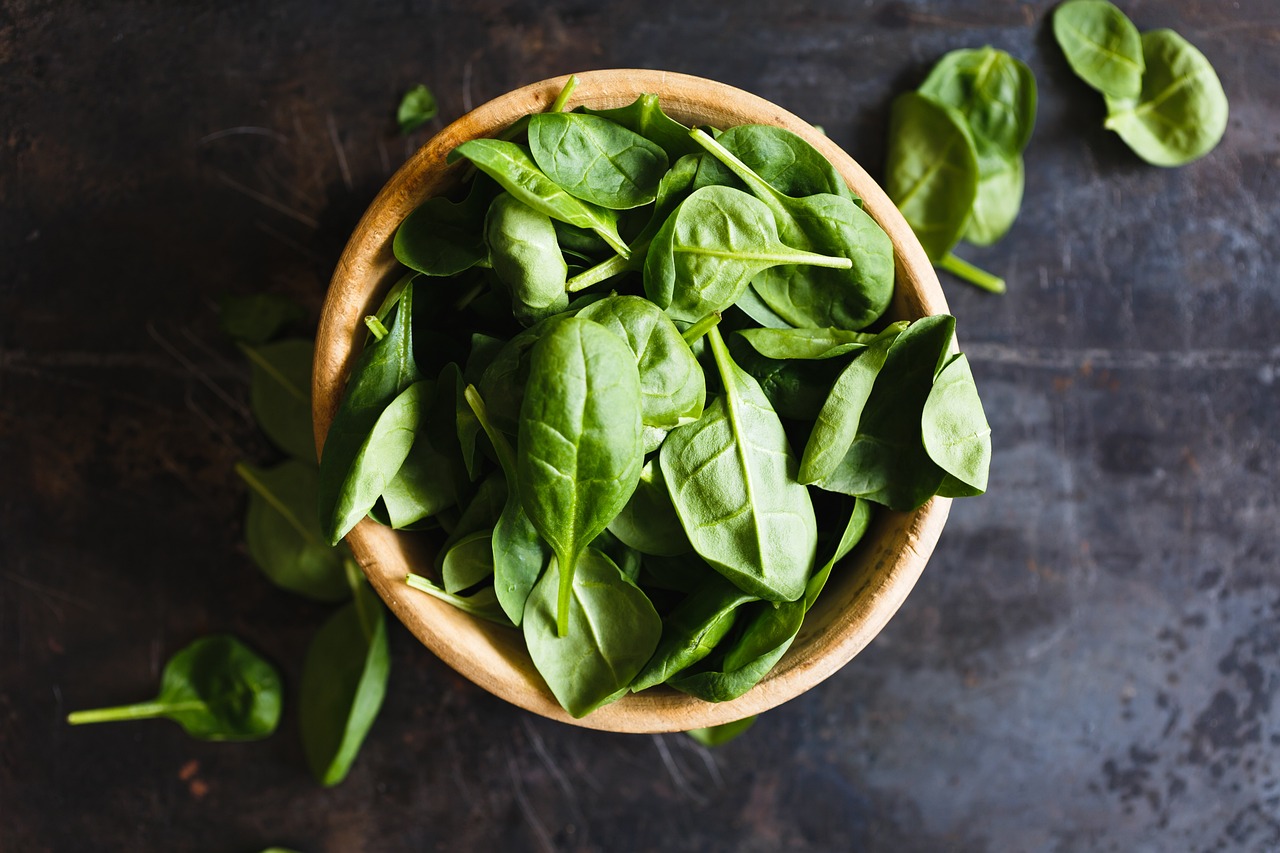
Reducing Fraud and Counterfeiting
In today's food industry, fraud and counterfeiting are rampant issues that threaten both consumer safety and brand integrity. Imagine biting into a juicy steak only to find out it’s not what you paid for! This is where blockchain technology steps in like a superhero, ready to save the day. By providing an immutable record of transactions, blockchain ensures that every product's history is transparent and verifiable.
One of the most compelling features of blockchain is its ability to create a digital fingerprint for each product. This fingerprint contains vital information, such as the origin of the ingredients, processing methods, and even the transportation routes taken. With this level of detail, consumers can trace their food back to its source, making it nearly impossible for counterfeit products to slip through the cracks.
Consider this: a recent study found that up to 10% of the food supply is estimated to be fraudulent. This includes everything from mislabeled fish to fake organic produce. Blockchain can help reduce this alarming statistic by ensuring that all claims made by producers are verified through a secure network of participants. When a consumer scans a QR code on their product, they can see its entire journey, which builds trust and reinforces the brand's reputation.
Furthermore, the transparency provided by blockchain can deter fraudsters from attempting to deceive consumers in the first place. When producers know that their claims are being monitored in real-time, they are less likely to engage in dishonest practices. The fear of getting caught in a web of blockchain's traceability is a powerful motivator for maintaining integrity.
To illustrate the effectiveness of blockchain in reducing fraud, let's take a look at a case study involving a well-known food brand. This company implemented a blockchain system that allowed consumers to track the journey of their products from farm to table. As a result, they reported a 30% decrease in fraudulent claims within the first year. Such statistics highlight the potential for blockchain to revolutionize the food industry by not just enhancing safety but also fortifying consumer trust.
However, it’s important to note that while blockchain is a powerful tool, it’s not a silver bullet. For it to be effective, there needs to be industry-wide collaboration. All players in the supply chain—from farmers to retailers—must participate in this digital ledger for it to work effectively. When everyone is on board, the chances of fraud decrease significantly.
In conclusion, blockchain technology is a game-changer in the fight against food fraud and counterfeiting. By providing a transparent, immutable record of transactions, it not only protects consumers but also empowers brands to uphold their integrity. As we continue to embrace this technology, the food industry can look forward to a future where trust and authenticity reign supreme.
- How does blockchain prevent food fraud? Blockchain creates an immutable record of transactions that allows consumers to trace the origins of their food, making it difficult for counterfeit products to enter the market.
- Can blockchain be implemented by small food producers? Yes, while there are challenges, many blockchain solutions are designed to be accessible for producers of all sizes, promoting transparency across the board.
- What are the costs associated with implementing blockchain in food supply chains? The costs can vary, but many companies find that the long-term savings from reduced fraud and improved efficiency outweigh the initial investment.
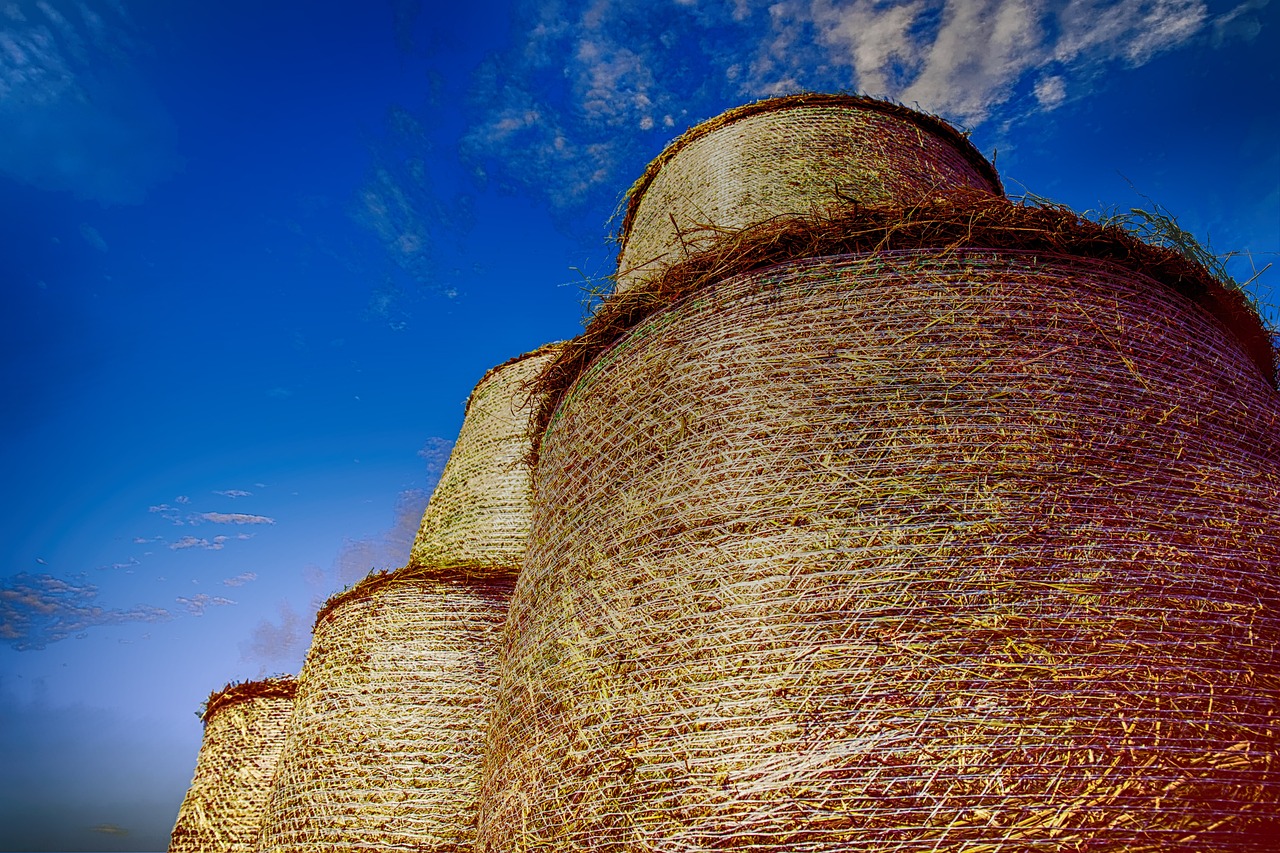
Future Trends in Blockchain and Food
The future of blockchain technology in the food industry is not just a passing trend; it's a revolution that promises to reshape how we think about food safety, transparency, and sustainability. As we look ahead, several key trends are emerging that are set to redefine the landscape. First and foremost, we can expect to see an increasing adoption of smart contracts. These self-executing contracts with the terms of the agreement directly written into code can automate various processes within the food supply chain, such as payments and quality checks. Imagine a world where a farmer receives payment automatically once their produce is delivered and verified by the retailer. This level of automation not only reduces the need for intermediaries but also speeds up transactions significantly.
Another exciting trend is the integration of Internet of Things (IoT) devices with blockchain technology. IoT devices can monitor conditions such as temperature and humidity during transportation. When paired with blockchain, this data becomes immutable and accessible to all parties involved in the supply chain. For instance, if a shipment of perishables deviates from the optimal temperature, the data recorded on the blockchain can trigger alerts, allowing suppliers to take immediate action to prevent spoilage. This synergy between IoT and blockchain enhances not only safety but also efficiency.
Furthermore, we can anticipate a rise in consumer demand for sustainability and ethical sourcing. As shoppers become more conscious of their choices, they will increasingly seek out brands that can prove their commitment to sustainable practices. Blockchain can facilitate this by providing transparent records of sourcing and production methods. For example, consumers can scan a QR code on their food packaging to access the entire journey of that product, from farm to table, including the farming practices used and the environmental impact. This level of transparency will not only empower consumers but also encourage brands to adopt more responsible practices.
Moreover, as we delve deeper into the future, the concept of collaborative networks will gain traction. Food industry stakeholders—ranging from farmers to retailers—will begin to form alliances to share data and insights on blockchain platforms. This collaborative approach can lead to improved efficiency and reduced waste across the supply chain. For instance, by sharing data on inventory levels, companies can better manage their stock and reduce overproduction, which is a significant contributor to food waste.
Lastly, regulatory frameworks surrounding blockchain in the food industry are likely to evolve. As the technology gains traction, governments and regulatory bodies will need to establish guidelines and standards to ensure its safe and effective implementation. This might involve creating certifications for blockchain systems that meet specific criteria, thereby increasing trust among consumers and businesses alike.
In summary, the future of blockchain in the food industry is bright and filled with potential. With advancements in smart contracts, IoT integration, sustainability demands, collaborative networks, and evolving regulations, we are on the brink of a transformative era. As these trends unfold, they will not only enhance the efficiency and safety of food supply chains but also empower consumers to make informed choices, ultimately leading to a more transparent and sustainable food system.
- What is blockchain technology?
Blockchain is a decentralized digital ledger that records transactions across many computers, ensuring that the record cannot be altered retroactively. - How does blockchain improve food safety?
By providing complete visibility into the supply chain, blockchain allows for quick identification of contamination sources, thereby enhancing food safety standards. - What role do smart contracts play in the food industry?
Smart contracts automate transactions and processes, ensuring that agreements are executed when conditions are met, thus streamlining operations. - How can consumers benefit from blockchain in food?
Consumers can access detailed information about the origins and handling of their food products, allowing them to make informed purchasing decisions. - What challenges does blockchain face in the food industry?
Challenges include high implementation costs, technological barriers, and the need for industry-wide collaboration to standardize practices.
Frequently Asked Questions
- What is blockchain technology?
Blockchain technology is a decentralized digital ledger that securely records transactions across many computers. It ensures that the recorded information cannot be altered retroactively, promoting transparency and trust.
- How does blockchain enhance traceability in the food supply chain?
Blockchain allows for real-time tracking of food products from their origin to the consumer's plate. This means every step of the journey is documented, enabling consumers to verify the source and quality of their food.
- Can blockchain improve food safety?
Absolutely! By providing complete visibility into the supply chain, blockchain helps quickly identify sources of contamination, reducing the impact of foodborne illnesses and enhancing overall food safety standards.
- What are some challenges in implementing blockchain in the food industry?
Challenges include high implementation costs, technological barriers, and the necessity for collaboration across the entire industry to ensure effectiveness and standardization.
- How does blockchain boost consumer confidence?
With increased transparency, consumers can access detailed information about the food they purchase, leading to informed choices and a greater willingness to support brands that prioritize transparency and quality.
- In what ways does blockchain streamline supply chain processes?
Blockchain automates various supply chain operations, reduces paperwork, and speeds up transactions, resulting in cost savings and efficiency for both producers and consumers.
- How does blockchain help reduce fraud and counterfeiting in the food industry?
Blockchain's immutable records ensure that product claims are verified and traceable, which helps protect brands and consumers from counterfeit products and fraudulent practices.
- What future trends can we expect with blockchain in the food industry?
As technology continues to evolve, we can anticipate greater integration of blockchain in the food industry, leading to innovations that enhance traceability, safety, and overall efficiency.

